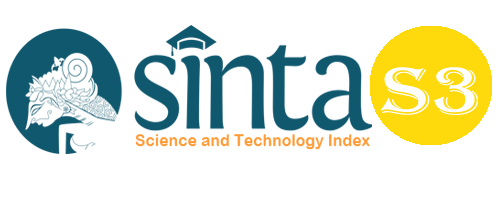Relationship between Knowledge, Clothing Cleanliness, Towel Cleanliness and Environmental Sanitation with Scabies Incidents at the Pekanbaru City Child Special Development Institute (LPKA) in 2019
Abstract
Scabies is a skin disease related to the environment and human behavior. In Indonesia, scabies is still a public health problem. Scabies is found in places with unsanitary environments and poor personal hygiene such as dormitories, Islamic boarding schools and prisons. In LPKA Pekanbaru City, there were 38.33% cases of scabies. This case increased from the previous year, where cases in 2017 were 34%. This study aims to analyze the factors that influence the incidence of scabies in the Class II Class II Special Development Institution for Children in Pekanbaru City in 2019. The research design used was cross sectional with a sample size of 120 children obtained using the total population. The instrument used in this study was a questionnaire. The data obtained in this study were analyzed by univariate, bivariate and multivariate using multiple logistic regression tests. The results showed that there was a relationship between cleanliness of clothes (p = 0.003), cleanliness of towels (p = 0.014), and environmental sanitation (p = 0.042) with the incidence of scabies. Meanwhile, the knowledge variable (p = 0.533) was not related to the incidence of scabies. In this study, if students have poor hygiene clothes, towels, and sanitation, they have the opportunity to experience scabies at the Pekanbaru City Children's Special Development Institute.
Keywords
Full Text:
PDFReferences
Agoes, R, (2009). Scabies ; Konsep pencegahan dan pengobatan pada komunitas di indonesia, Majalah Kedokteran Bandung. Diakses dari http://lubma2research.blogspot.co m/2011/04
Ariningtyas, D. N. (2019). Analisis karakteristik dan higiene individu dengan kejadian skabies. Jurnal Keperawatan Muhammadiyah
Azizah, Novi N. (2013). Hubungan antara kebersihan diri dan lama tinggal terhadap penularan penyakit skabies di pon-pes al hamdulillah rembang.skripsi.surakarta : Universitas Muhamadiyah Surakarta
Dinas Kesehatan Provinsi Riau. 2016. Profil Kesehatan Provinsi Riau Tahun 2015. Riau.
Djuanda A. (2007). Skabies. Ilmu penyakit kulit dan kelamin. (Edisi ke-5)
Erna, E., & Marta, M. (2013). Hubungan sanitasi lingkungan dan personal hygiene dengan kejadian penyakit scabies pada warga binaan pemasyarakatan di lembaga pemasyarakatan klas IIA jambi tahun 2013. Scientia Journal, 2(2), 70-78.
Farihah, Ummu. (2016). Analisis karakteristik santri, higiene perorangan dan sanitasi lingkungan dalam pengendalian skabies (studi di pondok pesantren qomaruddin kabupaten gresik). (Skripsi.Surabaya). Universitas Airlangga
Husda, H and Zubaida. (2018). Role Optimization of Indigenous Institutions for Case of Violence Against Women and Children (Analysis Study in Aceh and Padang Provinces). Budapest International Research and Critics Institute-Journal (BIRCI-Journal). P. 170-180
IACS. 2014. Skabies. http;//www.controlscabies.org/about-scabies/. Tanggal 20 Agustus 2019.
Julia, Rochis dan Sri T. B. U. (2013).Hubungan faktor lingkungan dan perilaku terhadap kejadian skabies di pondok pesantren al-furqon kecamatan sidayu kabu¬paten gresik provinsi jawa timur tahun 2013 (Skripsi). Universitas Indonesia, Jakarta.
Kemenkes RI. (2016). Profil Kesehatan Indonesia 2015. Keputusan Menteri Kesehatan Republik Indonesia. Jakarta
Ma’rufi I, Erdi I. dan Eri W. (2012). Hubungan perilaku se¬hat santri dengan kejadian scabies di pondok pe¬santren kabupaten lamongan. .Jurnal IKESMA, 8(2): pp.119-129.
Dfsdh
Mansyur. M. (2007). Pendekatan kedokteran keluarga pada penatalaksanaan skabies anak usia pra-sekolah. Majalah Kedokteran Indonesia . Vol. 57, No. 2, Februari 2007. Hal : 63-67
Noor, Nur Nasry. (2008). Epidemiologi. Jakarta: Rineka Cipta
Notoatmodjo, S.. (2007). Promosi Kesehatan dan Ilmu Perilaku. Jakarta : Rineka Cipta.
Notoatmodjo, S. (2012). Metodologi penelitian kesehatan. Jakarta : Rineka Cipta.
Pawening, A. (2009). Perbedaan angka kejadian skabies antar kelompok santri berdasar lama belajar di pesanten. Universitas Negeri Semarang
Ridwan, A. R., Sahrudin, S., & Ibrahim, K. (2017). Hubungan pengetahuan, personal hygiene, dan kepadatan hunian dengan gejala penyakit skabies pada santri di pondok pesantren darul muklisin.. Jurnal Ilmiah Mahasiswa Kesehatan Masyarakat, Kendari.
Rohmawati RN. (2010). Hubungan antara faktor pengetahuan dan perilaku dengan kejadian skabies di pondok pesantren al-muayyad surakarta. Fakultas Kedokteran Universitas Muhammadiyah, Surakarta.
Shinta, H., et al. (2020). Potential Stunting in Riverside Peoples (Study on Pahandut Urban Village, Palangka Raya City). Budapest International Research and Critics Institute-Journal (BIRCI-Journal). P. 1618-1625
Soedarto, M. (2003). Skabies dalam daili sf, makes wib, zubier f, dkk. penyakit menular seksual. (Edisi ke-2). FKUI, Jakarta.
Suyono, B. (2011). Ilmu kesehatan masyarakat dalam konteks kesehatan lingkungan. Penerbit Buku Kedokteran, EGC, Jakarta.
WHO. (2009). Epidemiology and management of common skin disease in children in developing countries. (serial di internet). (http://www.who.int/bulletin/volumes/87/2/07-047308/en/edit, diakses 12 Agustus 2019).
DOI: https://doi.org/10.33258/birci.v4i1.1542
Article Metrics
Abstract view : 415 timesPDF - 256 times
Refbacks
- There are currently no refbacks.

This work is licensed under a Creative Commons Attribution-ShareAlike 4.0 International License.

This work is licensed under a Creative Commons Attribution-ShareAlike 4.0 International License.

_.gif)

















_.gif)



